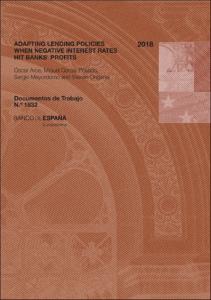Registro completo de metadatos
| Campo DC | Valor |
|---|---|
| dc.contributor.author | Arce, Óscar |
| dc.contributor.author | García-Posada, Miguel |
| dc.contributor.author | Mayordomo, Sergio |
| dc.contributor.author | Ongena, Steven |
| dc.date.accessioned | 2019-08-14T07:36:20Z |
| dc.date.available | 2019-08-14T07:36:20Z |
| dc.date.issued | 2018-09-11 |
| dc.identifier.issn | ISSN: 1579-8666 (en línea) |
| dc.identifier.uri | https://repositorio.bde.es/handle/123456789/8831 |
| dc.description | SANFI Award to the best paper on Banking of the 26th Finance Forum, held in Santander on 5-6 July 2018 |
| dc.description.abstract | ¿Cuál es el impacto de los tipos de interés negativos en la oferta de crédito y en la asunción de riesgos por parte de los bancos? Para responder a esta pregunta estudiamos los cambios en las políticas crediticias a partir de la Encuesta sobre Préstamos Bancarios del área del euro y de registro de crédito español. Los bancos cuyos ingresos netos por intereses están adversamente afectados por los tipos de interés negativos están poco capitalizados, corren menos riesgos y ajustan las condiciones de los préstamos para reforzar sus activos ponderados por riesgo y sus ratios de capital. Estos bancos también aumentan sus comisiones. Por el contrario, no encontramos diferencias en la oferta de crédito y en los criterios de concesión de préstamos ni en el área del euro ni en España. Estos resultados sugieren que los tipos de interés negativos no contraen necesariamente la oferta de crédito y que el reversal rate aún no se ha alcanzado |
| dc.description.abstract | What is the impact of negative interest rates on bank lending and risk-taking? To answer this question we study the changes in lending policies using both the Euro area Bank Lending Survey and the Spanish Credit Register. Banks whose net interest income is adversely affected by negative rates are concurrently lowly capitalized, take less risk and adjust loan terms and conditions to shore up their risk weighted assets and capital ratios. These banks also increase non-interest charges more. But, importantly, we find no differences in banks’ credit supply or standard setting, neither in the Euro area nor in Spain. These findings suggest that negative rates do not necessarily contract the supply of credit and that the so-called “reversal rate” may not have been reached yet |
| dc.format.extent | 47 p. : gráficos, tablas |
| dc.language.iso | en |
| dc.publisher | Banco de España |
| dc.relation.ispartof | Documentos de Trabajo / Banco de España, 1832 |
| dc.rights | Reconocimiento-NoComercial-CompartirIgual 4.0 Internacional (CC BY-NC-SA 4.0) |
| dc.rights | In Copyright - Non Commercial Use Permitted |
| dc.rights.uri | https://creativecommons.org/licenses/by-nc-sa/4.0/deed.es_ES |
| dc.rights.uri | http://rightsstatements.org/vocab/InC-NC/1.0/ |
| dc.subject | Tipos de interés negativos |
| dc.subject | Asunción de riesgos |
| dc.subject | Políticas crediticias |
| dc.subject | Negative interest rates |
| dc.subject | Risk taking |
| dc.subject | Lending policies |
| dc.title | Adapting lending policies when negative interest rates hit banks’ profits |
| dc.type | Documento de trabajo |
| dc.identifier.bdebib | 000462711 |
| dc.identifier.bdepub | DTRA-201832-eng |
| dc.subject.bde | Créditos |
| dc.subject.bde | Política monetaria |
| dc.subject.bde | Bancos centrales y otras autoridades monetarias |
| dc.publisher.bde | Madrid : Banco de España, 2018 |
| dc.subject.jel | G21 |
| dc.subject.jel | E52 |
| dc.subject.jel | E58 |












